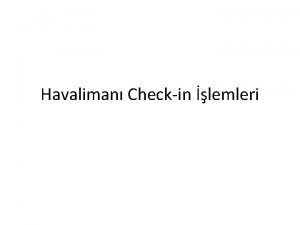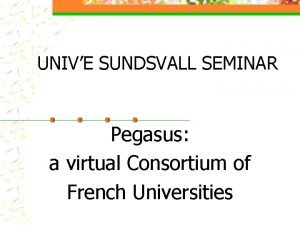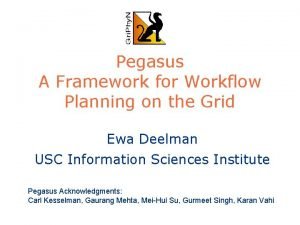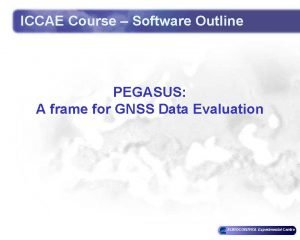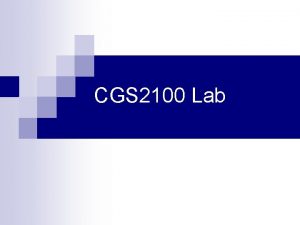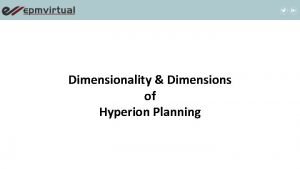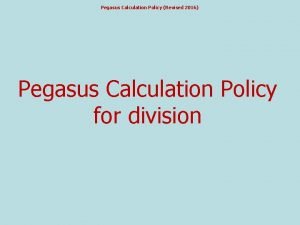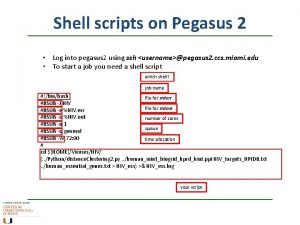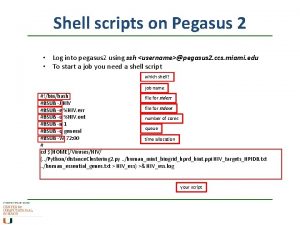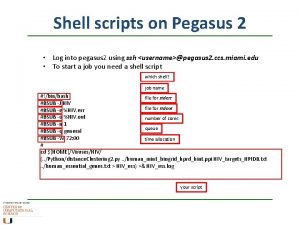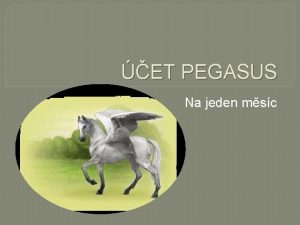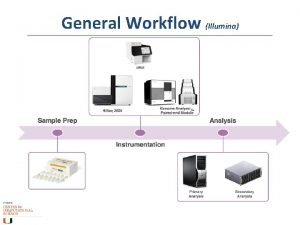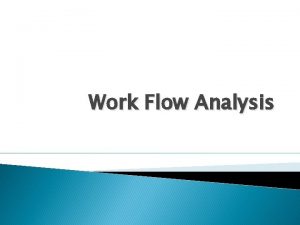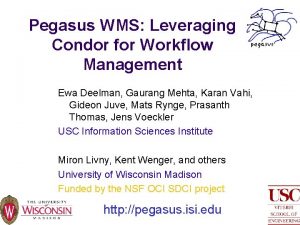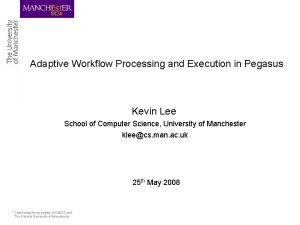Pegasus A Framework for Workflow Planning on the


















- Slides: 18

Pegasus A Framework for Workflow Planning on the Grid Ewa Deelman USC Information Sciences Institute Pegasus Acknowledgments: Carl Kesselman, Gaurang Mehta, Mei-Hui Su, Gurmeet Singh, Karan Vahi

Pegasus l l Flexible framework, maps abstract workflows onto the Grid Possess well-defined APIs and clients for: – Information gathering > Resource information > Replica query mechanism > Transformation catalog query mechanism – Resource selection > Compute site selection > Replica selection – Data transfer mechanism l Can support a variety of workflow executors pegasus. isi. edu Ewa Deelman

Pegasus l l l Job a May reduce the workflow based on available data products Augments the workflow with data stage-in and data stage-out Augments the workflow with data registration Job b Job c Job e Job g Job b Job c Job f Job d Job a Job h Job d Job e Job g Job h Job i pegasus. isi. edu Ewa Deelman KEY The original node Pull transfer node Registration node Push transfer node Inter-pool transfer node

Pegasus Components pegasus. isi. edu Ewa Deelman

Original Pegasus configuration Simple scheduling: random or round robin using well-defined scheduling interfaces. pegasus. isi. edu Ewa Deelman

Deferred Planning through Partitioning A variety of planning algorithms can be implemented pegasus. isi. edu Ewa Deelman

Mega DAG is created by Pegasus and then submitted to DAGMan pegasus. isi. edu Ewa Deelman

Re-planning capabilities pegasus. isi. edu Ewa Deelman

Complex Replanning for Free (almost) pegasus. isi. edu Ewa Deelman

Optimizations l If the workflow being refined by Pegasus consists of only 1 node – Create a condor submit node rather than a dagman node – This optimization can leverage Euryale’s super-node writing component pegasus. isi. edu Ewa Deelman

Planning & Scheduling Granularity l Partitioning – Allows to set the granularity of planning ahead l Node aggregation – Allows to combine nodes in the workflow and schedule them as one unit (minimizes the scheduling overheads) – May reduce the overheads of making scheduling and planning decisions l Related but separate concepts – Small jobs > High-level of node aggregation > Large partitions – Very dynamic system > Small partitions pegasus. isi. edu Ewa Deelman

l Montage (NASA and NVO) – Deliver science-grade custom mosaics on demand – Produce mosaics from a wide range of data sources (possibly in different spectra) – User-specified parameters of projection, coordinates, size, rotation and spatial sampling. l l Montage Bruce Berriman, John Good, Anastasia Laity, Caltech/IPAC Joseph C. Jacob, Daniel S. Katz, JPL Doing large: 6 and 10 degree dags (for the m 16 cluster). The 6 degree runs had about 13, 000 compute jobs and the 10 degree run had about 40, 000 compute jobs Mosaic created by Pegasus based Montage from a run of the M 101 galaxy images on the Teragrid. pegasus. isi. edu Ewa Deelman

Montage Workflow Data Stage in nodes Montage compute nodes Data stage out nodes Inter pool transfer nodes pegasus. isi. edu Ewa Deelman

Future work l Staging in executables on demand l Expanding the scheduling plug-ins l l Investigating various partitioning approaches Investigating reliability across partitions pegasus. isi. edu Ewa Deelman

l Non-Gri. Phy. N applications using Pegasus Galaxy Morphology (National Virtual Observatory) – Investigates the dynamical state of galaxy clusters – Explores galaxy evolution inside the context of largescale structure. – Uses galaxy morphologies as a probe of the star formation and stellar distribution history of the galaxies inside the clusters. – Data intensive computations involving hundreds of galaxies in a cluster The x-ray emission is shown in blue, and the optical mission is in red. The colored dots are located at the positions of the galaxies within the cluster; the dot color represents the value of the asymmetry index. Blue dots represent the most asymmetric galaxies and are scattered throughout the image, while orange are the most symmetric, indicative of elliptical galaxies, are concentrated more toward the center. pegasus. isi. edu Ewa Deelman

BLAST: set of sequence comparison algorithms that are used to search sequence databases for optimal local alignments to a query 2 major runs were performed using Chimera and Pegasus: 1) 60 genomes (4, 000 sequences each), In 24 hours processed Genomes selected from DOE-sponsored sequencing projects 67 CPU-days of processing time delivered ~ 10, 000 Grid jobs >200, 000 BLAST executions 50 GB of data generated 2) 450 genomes processed Speedup of 5 -20 times were achieved because the compute nodes we used efficiently by keeping the submission of the jobs to the compute cluster constant. Lead by Veronika Nefedova (ANL) as part of the PACI Data Quest Expedition program pegasus. isi. edu Ewa Deelman

Biology Applications (cont’d) Tomography (NIH-funded project) l Derivation of 3 D structure from a series of 2 D electron microscopic projection images, l Reconstruction and detailed structural analysis – complex structures like synapses – large structures like dendritic spines. l l Acquisition and generation of huge amounts of data Large amount of state-of-the-art image processing required to segment structures from extraneous background. Dendrite structure to be rendered by Tomography Work performed by Mei Hui-Su with Mark Ellisman, Steve Peltier, Abel Lin, Thomas Molina (SDSC) pegasus. isi. edu Ewa Deelman

Southern California Earthquake Center The SCEC/IT project, funded by (NSF), is developing a new framework for physics-based simulations for seismic hazard analysis building on several information technology areas, including knowledge representation and reasoning, knowledge acquisition, grid computing, and digital libraries. People involved: Vipin Gupta, Phil Maechling (USC) pegasus. isi. edu Ewa Deelman
 Pegasus pipeline
Pegasus pipeline Pegasus opera 3 auto enrolment
Pegasus opera 3 auto enrolment Pegasus check in
Pegasus check in Slidetodoc.com
Slidetodoc.com For seminar
For seminar Xxxn.cim
Xxxn.cim Pegasus
Pegasus Pegasus
Pegasus Pegasus outline
Pegasus outline Cgs homepage
Cgs homepage Oracle hyperion tutorial
Oracle hyperion tutorial Fspos
Fspos Novell typiska drag
Novell typiska drag Tack för att ni lyssnade bild
Tack för att ni lyssnade bild Vad står k.r.å.k.a.n för
Vad står k.r.å.k.a.n för Varför kallas perioden 1918-1939 för mellankrigstiden?
Varför kallas perioden 1918-1939 för mellankrigstiden? En lathund för arbete med kontinuitetshantering
En lathund för arbete med kontinuitetshantering Särskild löneskatt för pensionskostnader
Särskild löneskatt för pensionskostnader Tidbok yrkesförare
Tidbok yrkesförare


